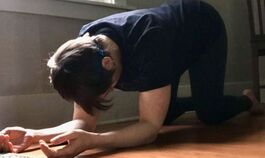|
This can be one of those lessons where you try something, take a break, try it again, take a break. Remember to decrease the amount of effort as you become comfortable/oriented to a movement. One of the signs of using a lot of effort is your breathing (or lack there-of). Another sign might be using your upper body to lift your pelvis, or pinning your head in the center during rolling movements. Remember, the movements are here for you to learn about yourself: in themselves, the movements aren't the point. So more/larger isn't better. Small, and clear is more helpful. Feel what you do. Feel the trajectory of movement. Listen for ease in your breath, hands, jaw, and eyes as you go.
Available on Patreon patreon.com/heatherdanso
0 Comments
Begins with an exploration of standing and weight shifting. When we discuss in the beginning, there are at least three ways to shift your weight side to side: 1. Like a tree, all one long pole from ankle to head, shifting side to side with most of the movement happening in the ankle. 2. Swinging the head in the opposite direction as a counter balance, like a large C-shape. This is how we balance in side bending standing poses in yoga. (It is almost a subset of #3) 3. Leaving the head in the middle, doing all the shifting in the vertebrae and hips, legs, and ankles. This is a movement that we do in very well-organized walking. The movement lesson begins around 10-12 minutes, after scanning in lying, playing in standing shigting weigh, and scanning again. We find our way onto forearms and knees--a demanding position. This is a compound lesson with elements from a few ATMs, so no formal name or source. TAKE IT EASY. Remember to take breaks. To have the full length class, download the file (it is 1 hour)
How would you like to approach your learning? If each of these lessons is an experience in which you get to try on your learning--how would you play with that idea? A possibly challenging lesson, as all lessons are. Be mindful to make your padding for your knees wide enough that you have many options for how wide to place your knees as you move. The sound changes a bit for the second half, as my ear piece dies, but I did amplify it, so perhaps it is alright. Half of this lesson is active, half in the imagination. Position: On hands and knees, on knees, on back
This is a partial recording of an amalgamation of many lessons and much playing. A lesson in standing, feel free to take time to rest seated, or lying on the ground. 22 minutes only, available.
Releasing the Hips by holding the feetIn today's lesson, we will do movements similar to this, in a lesson based on the Alexander Yanai Awareness Through Movement® lesson. The image can be useful, as we use our eyes to learn, as well as our sensing. But, as with any image, the purpose is to help you discover the possibility for movement within your own system, and that possibility may be smaller, feel different, require a speed that allows for you to deeply sense yourself.
Only work in ease and curiosity, when you are stuck, use your imagination. Next week, we continue on with building intelligence in the hip-joint, which affects the knees, and the feet! Audio to be posted after class this evening. |
HOW-TORecorded at public classes, All audio classes are now on Patreon. Please read the HOW-TO before doing a lesson. Archives
April 2024
Categories
All
|
||||||||||||||||||
Heather Emanuel, GCFPSchedule Appointment
|
|


 RSS Feed
RSS Feed